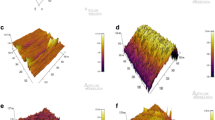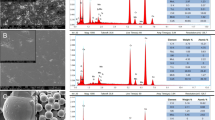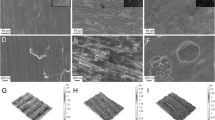Abstract
It is of the utmost importance to increase the activity of bone cells on the surface of materials used in the design of orthopaedic implants. Increased activity of such cells can promote either integration of these materials into surrounding bone or complete replacement with naturally produced bone if biodegradable materials are used. Osteoblasts are bone-producing cells and, for that reason, are the cells of interest in initial studies of new orthopaedic implants. If these cells are functioning normally, they lay down bone matrix onto both existing bone and prosthetic materials implanted into the body. It is generally accepted that a successful material should enhance osteoblast function, leading to more bone deposition and, consequently, increased strength of the interface between the material and juxtaposed bone. The present study provided the first evidence of greater osteoblast function on carbon and alumina formulations that mimic the nano-dimensional crystal geometry of hydroxyapatite found in bone.
Similar content being viewed by others
References
Anderson, J. M., Gristina, A. G., Hanson, S. R., Harker, L. A., Johnson, R. J., Merritt, K., Naylor, P. T., andSchoen, F. J. (1996): ‘Host reactions to biomaterials and their evaluation’, inRatner, B. D., Hoffman, A. S., Shoen, F. J., andLemons, J. E. (Eds): ‘Biomaterials science: an introduction to materials in medicine’ (Academic Press, London, 1996), pp. 165–215
Coathup, M. J., Blunn, G. W., Flynn, N., Williams, C., andThomas, N. P. (2001): ‘A comparison of bone remodeling around hydroxyapatite-coated, porous-coated and grit-blasted hip replacements retrieved at post-mortem’,J. Bone & Joint Surg. Brit.,83, pp. 118–123
Dee, K. C., Rueger, D. C., Andersen, T. T., andBizios, R. (1996): ‘Conditions which promote mineralization at the bone-implant interface: a modelin vitro study’,Biomaterials,17, pp. 209–215
Elias, K. E., Price, R. L., andWebster, T. J. (2001): ‘Enhanced functions of osteoblasts on carbon nanofiber compacts’,Biomaterials
Gutwein, L. G., Tepper, F., andWebster, T. J. (2002): ‘Increased osteoblast function on nanofibered alumina’,American Ceramic Society 26th Annual Meeting Conf. Proc.
Kaplan, F. S., Hayes, W. C., Keaveny, T. M., Boskey, A., Einhorn, T. A., Iannotti, J. P., andSimon, S. P. (1994): ‘Orthopaedic basic science’ (American Academy of Orthopaedic Surgeons, Columbus, Ohio, 1994), pp. 127–185
Kay, S., Thapa, A., Haberstroh, K. M., andWebster, T. J. (2002): ‘Nanostructured polymer: nanophase ceramic composites enhance osteoblast and chondrocyte adhesion’,Tissue Eng.,8, pp. 753–761
Ma, P. X., andZhang, R. (1999): ‘Synthetic nano-scale fibrous extracellular matrix’,J. Biomed. Mater. Res.,46, pp. 60–72
Miller, D. M., Thapa, A., Haberstroh, K. M., andWebster, T. J. (2002): ‘Anin vitro study of nano-fiber polymers for guided vascular regeneration’, Materials Research Society Symposium Proc.,711, pp. GG3.2.1-GG3.2.4
Montgomery, D. C. (Ed) (1991): ‘Design and analysis of experiments’ (John Wiley & Sons, Inc., New York, 1991), pp. 28–30
Ogiso, M., Yamashita, Y., andMatsumoto, T. (1998): ‘Differences in microstructural characteristics of dense HA and HA coating’,J. Biomed. Mater. Res.,41, pp. 296–303
Park, J. B., andLakes, R. S. (1992): ‘Biomaterials: an introduction’ (Plenum Press, New York, London, 1992)
Price, R. L., Elias, K. L., Haberstroh, K. M., andWebster, T. J. (2001): ‘Small diameter, high surface energy carbon nanofiber formulations that selectively increase osteoblast function’, Mater. Res. Soc. Spring 2001 Meeting Conf. Proc.
Rodriguez, N. M. (1993): ‘A review of catalytically grown carbon nanofibers’,J. Mater. Res.,8, pp. 3233–3250
Tepper, F., Lerner, M., andGinley, D. (2001): ‘Nanosized alumina fibers’,Am. Ceramic Soc. Bull.,80, pp. 57–60
Thapa, A., Webster, T. J., andHaberstroh, K. M. (2002): ‘An investigation of nano-structured polymers for use as bladder tissue replacement constructs’,Materials Research Society Symposium Proceedings,711, pp. GG3.4.1-GG3.4.6
Webster, T. J. (2001): ‘Nanophase ceramics: the future orthopedic and dental implant material’,Adv. Chem. Eng.,27, pp. 125–166
Webster, T. J., Siegel, R. W., andBizios, R. (2001a): ‘Nanoceramic surface roughness enhances osteoblast and osteoclast functions for improved orthopaedic/dental implant efficacy’,Scripta Materialia,44, pp. 1639–1642
Webster, T. J., Ergun, C., Doremus, R. H., Siegel, R. W., andBizios, R. (2001b): ‘Enhanced function of osteoblasts on nanophase ceramics’,Biomaterials,21, pp. 1803–1810
Author information
Authors and Affiliations
Corresponding author
Rights and permissions
About this article
Cite this article
Price, R.L., Haberstroh, K.M. & Webster, T.J. Enhanced functions of osteoblasts on nanostructured surfaces of carbon and alumina. Med. Biol. Eng. Comput. 41, 372–375 (2003). https://doi.org/10.1007/BF02348445
Received:
Accepted:
Issue Date:
DOI: https://doi.org/10.1007/BF02348445




